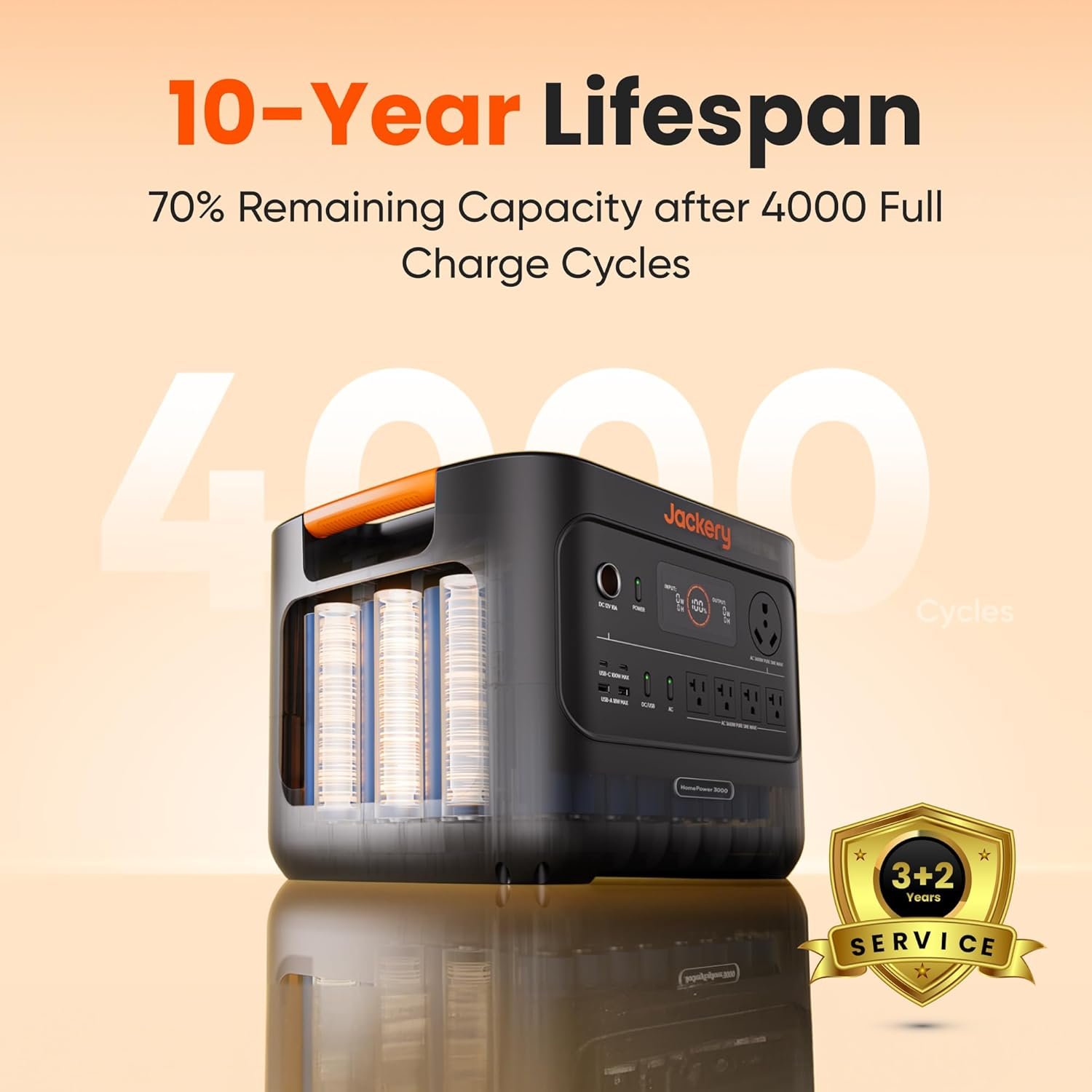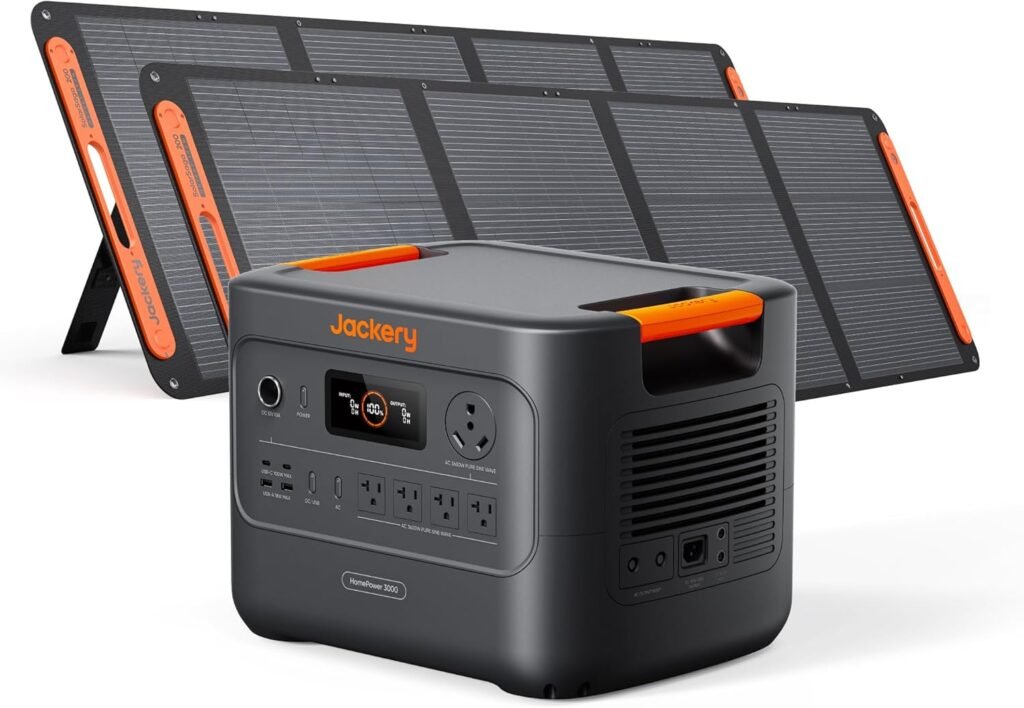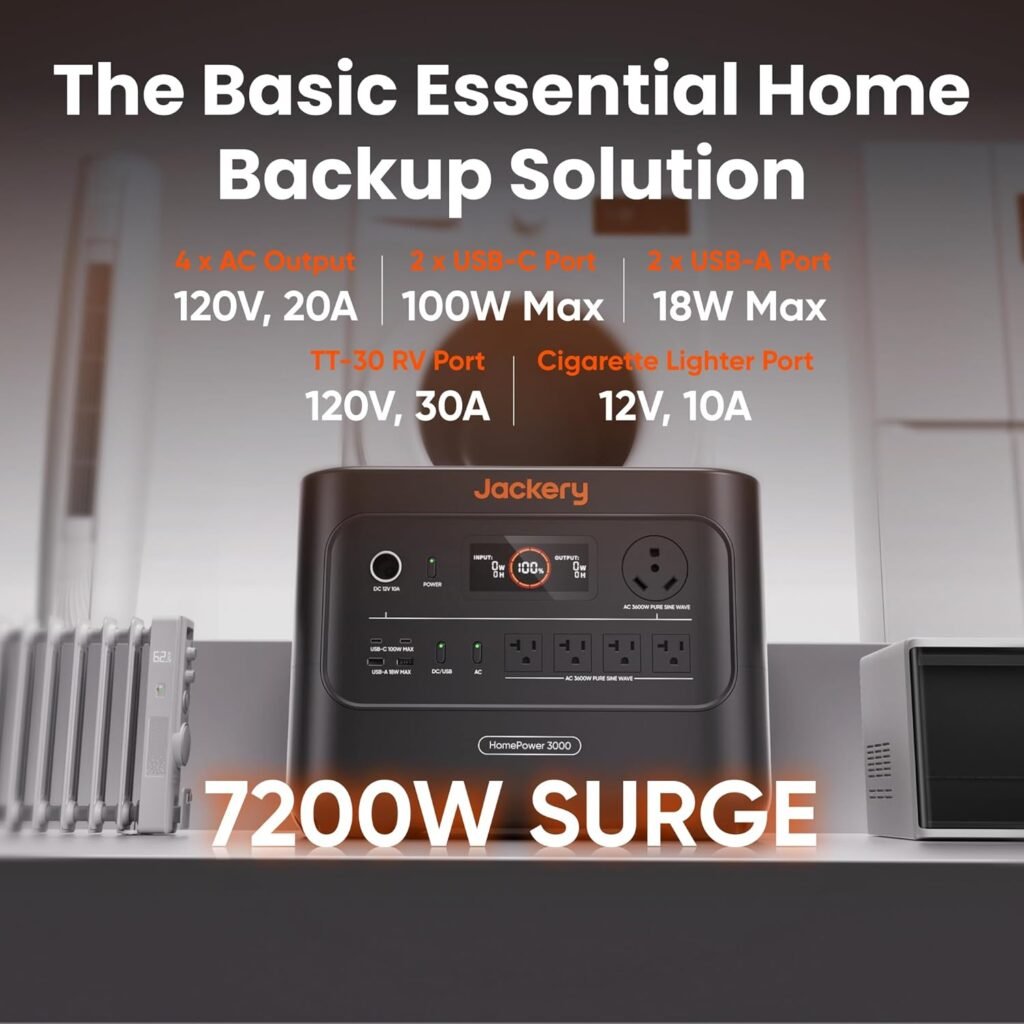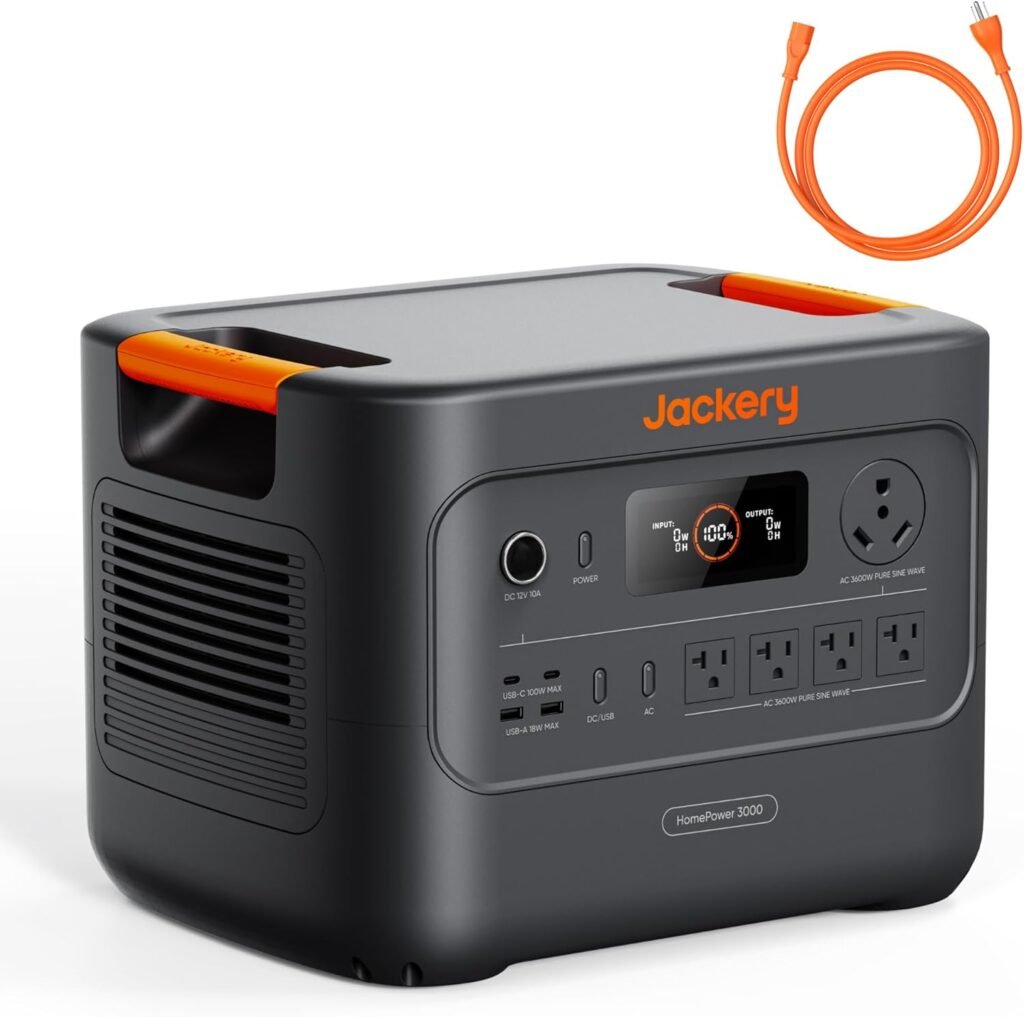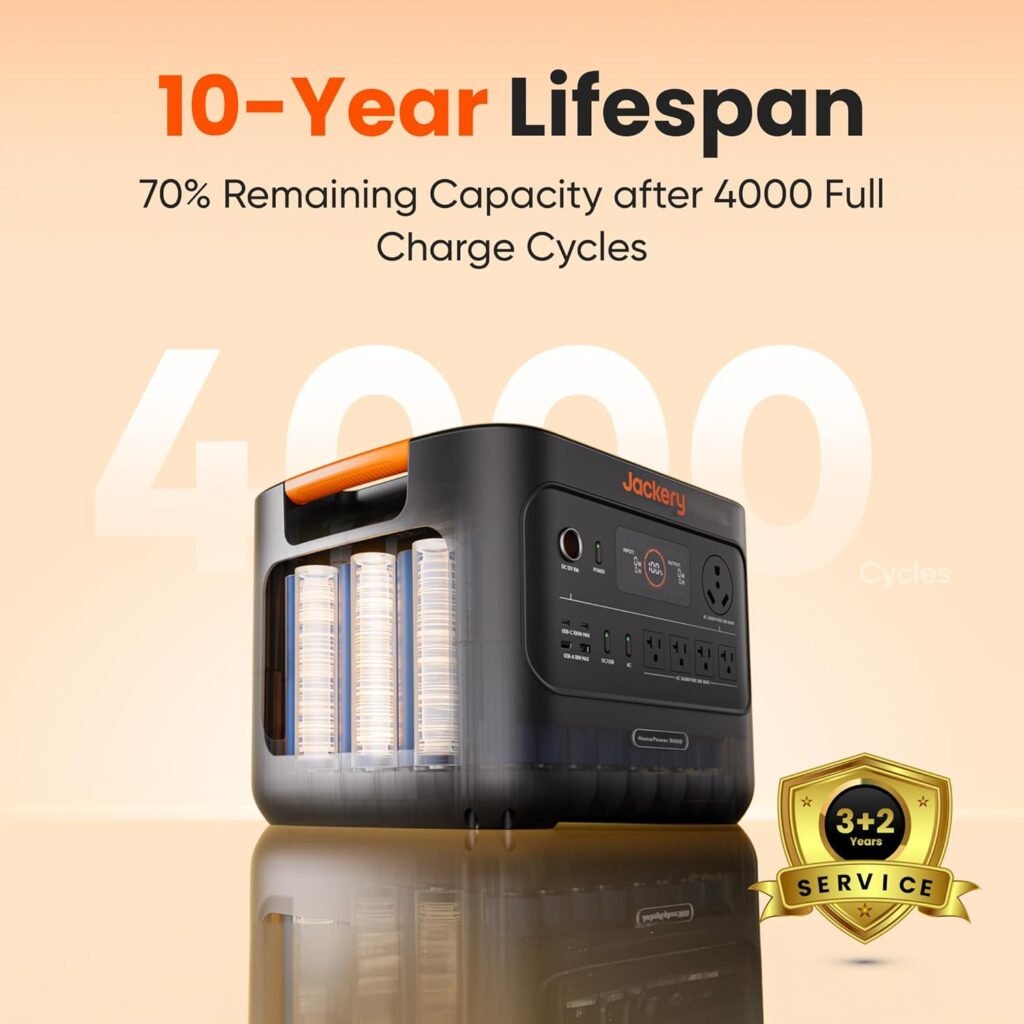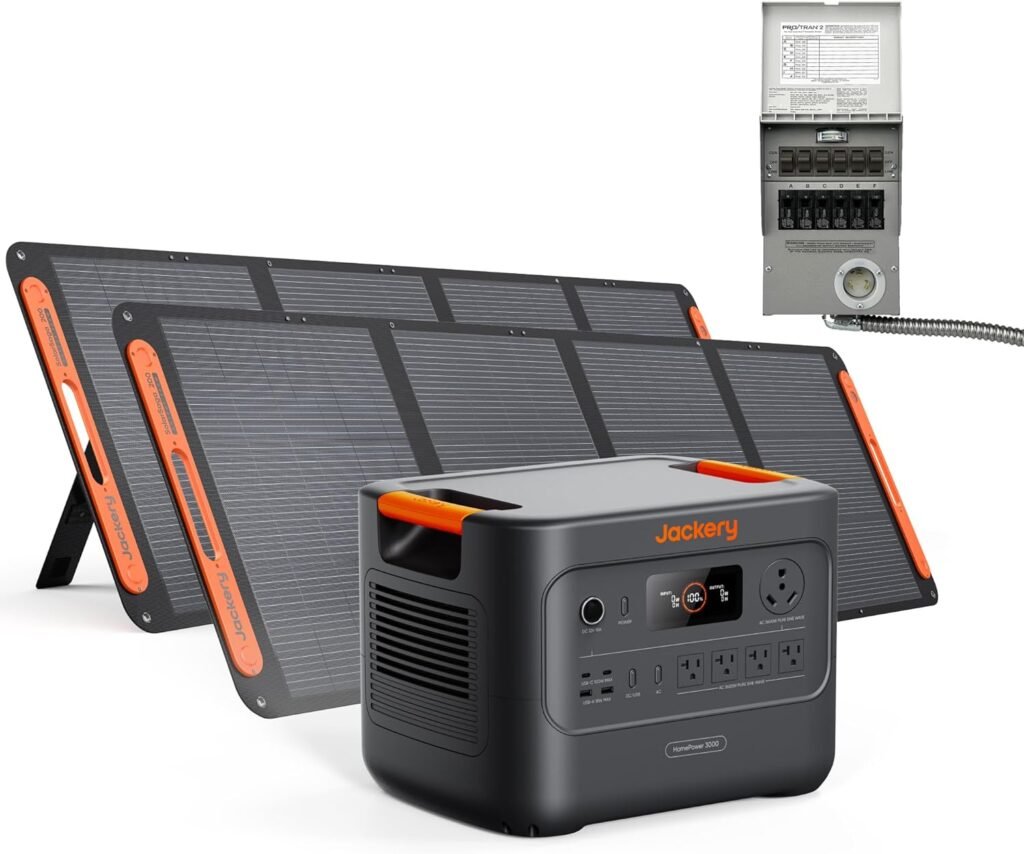Jackery HomePower 3000 review
Looking for a reliable portable power station that can actually handle your home essentials during an outage and still be useful on the road?
Product Summary: Jackery HomePower 3000 Portable Power Station
You’ll find this unit marketed as the Jackery HomePower 3000 Portable Power Station with 2x 200W Solar Panels, 3600W (Surge 7200W) Output, 3072Wh LFP Battery Solar Generator, Essential Backup for Home Use, Power Outage, RV, Emergencies. This summary gives you the core specs and what they mean for your everyday needs, so you can quickly decide if it fits your lifestyle.
Key Specifications at a Glance
These are the headline figures you’ll care about when comparing models or planning what to run. They tell you how much energy you have, how much you can push through at once, and how quickly you can get back to full power.
| Spec | Value | What it means for you |
|---|---|---|
| Battery Capacity | 3072 Wh (LiFePO4) | Enough to run multiple essentials for several hours or a fridge for 1–2 days depending on usage. |
| Continuous Output | 3600 W | Can power larger household appliances simultaneously like microwaves, freezers, or multiple devices. |
| Surge Output | 7200 W | Short bursts let motors and compressors (like fridge or air conditioner start-up) kick in without tripping. |
| Battery Chemistry | LiFePO4 (LFP) | Long lifespan (approx. 4,000 cycles to 70% capacity) and safer thermal performance. |
| UPS Switch Time | ≤20 ms (UL-certified) | Your devices stay online through most outages without rebooting or losing connection. |
| Included Solar Panels | 2 × 200W SolarSaga panels | Enables off-grid recharge and shorter solar charging times when conditions are good. |
| Fast Recharge (AC) | 1.7 hrs (hybrid) / 2.2 hrs (AC only) | Rapid replenishment so you’re back to full capacity quickly. |
| Solar Charge (80%) | ~9 hrs with 2× 200W panels | Daytime recharging option; depends on sun and panel orientation. |
| Weight & Size | Industry-leading compact footprint | Smaller and lighter than many other 3 kWh stations thanks to CTB technology. |
| Special Ports | Dual 100W PD USB-C, TT-30 RV port | Fast device charging and RV-ready plug-and-play convenience. |
| Extra Charging | 12V car, gas generator | Flexible replenishment when solar or AC is unavailable. |
Performance and Real-World Output
You’ll want practical performance, not just nice numbers. This section explains what those specs translate to in your daily life and during emergencies.
Continuous and Surge Performance
The 3600W continuous and 7200W surge output mean you can run high-demand appliances that many portable stations can’t handle. You’ll have enough headroom to start compressors, microwaves, and multiple AC circuits without immediately overloading the system.
Runtime Examples
It’s useful to see typical runtimes so you can plan during outages or when boondocking. Below are example run times for common devices based on the 3072Wh battery — real-world results will vary with device efficiency and usage patterns.
| Device | Typical Power Draw | Estimated Runtime (3072Wh) |
|---|---|---|
| Refrigerator (modern, avg.) | 100–200 W running | 1–2 days (with cycling) |
| Chest freezer | 75–150 W running | 1–2+ days (depending on duty cycle) |
| Laptop (USB-C PD) | 45–100 W | 20–60+ hours (depending on model) |
| LED lights (home, 10x) | 50–100 W | 30–60+ hours |
| WiFi router + modem | 10–30 W | 100+ hours |
| CPAP machine | 30–60 W | 40–100+ hours (depending on settings) |
| Electric kettle (boil) | 1500–2000 W | Multiple quick boils (but high draw shortens total available energy) |
| Portable AC (small/efficient) | 800–1500 W | Several hours if sized correctly; check start-up surge limits |
Battery Technology and Lifespan
You’ll want a battery that lasts through many cycles and is safe. Jackery uses LiFePO4 chemistry which is optimized for longevity and thermal stability.
LiFePO4 Benefits
LiFePO4 offers better cycle life and improved safety compared with many lithium chemistries. For you, this translates to approximately 4,000 cycles while retaining about 70% capacity — a meaningful advantage if you plan frequent use.
ChargeShield 2.0 & AI Optimization
Jackery’s ChargeShield 2.0 incorporates proprietary AI algorithms to optimize charging speed and protect the battery long-term. You’ll notice faster consistent charge times and better battery health over years of use when ChargeShield is active.
Charging Options and Times
Charging flexibility is crucial so you’re not stranded. The HomePower 3000 gives you multiple charging methods to suit home, road, or off-grid scenarios.
AC and Hybrid Charging
You can recharge fast: 2.2 hours via AC alone, and about 1.7 hours with a hybrid AC+DC input. That means you can go from near-empty to usable capacity in a morning or an afternoon, which helps during extended outages.
Solar Charging with 2x 200W Panels
With the included SolarSaga 200W panels, you can reach roughly 80% in around 9 hours of good sunlight. If you’re off-grid, this will usually let you recover most of your daily consumption within a sunny day.
Alternative Charging Methods
You also have a 12V car charging option and the ability to recharge via a gas generator. These give you the flexibility to top off the station when solar or grid power aren’t practical.
Ports, Outputs, and Device Compatibility
You’ll find a wide variety of ports for modern devices. This helps you charge fast and run legacy appliances at the same time.
AC, DC, and USB Outputs
The HomePower 3000 includes multiple AC outlets, USB-A, dual 100W USB-C PD ports, and DC outputs including a TT-30 RV port. You’ll be able to fast-charge laptops, phones, drones, and plug in your RV or car accessories directly.
Dual 100W PD USB-C Advantage
With two 100W USB-C PD ports, you can rapidly charge high-watt laptops and power-hungry devices without needing bulky chargers. This is especially useful if you work remotely and rely on your laptop and phone all day.
UPS Function and Outage Behavior
If you use sensitive equipment, UPS performance matters. The HomePower 3000 offers a near-instant switch to battery power during an outage.
UL-Certified ≤20 ms Switching
The unit’s UPS is UL-certified and switches in ≤20 ms, which keeps most routers, security systems, and medical devices running without interruption. You’ll appreciate the continuity for Zoom calls, security recording, and timed pet feeders.
Practical UPS Use
In day-to-day use, you’ll set the HomePower 3000 to supply critical circuits or specific devices so they remain powered automatically when the grid drops. This minimizes downtime and prevents device resets during momentary outages.
Design, Portability, and Build Quality
You’ll care about size, weight, and durability if you plan to move the unit between home, RV, and outdoors. Jackery has focused on compactness and sturdiness.
CTB Technology and Compact Footprint
This is billed as the world’s first 3kWh portable power station using CTB technology, which makes it 47% smaller and 43% lighter than comparable 3 kWh models. You’ll find it easier to carry and store while still having high capacity.
Honeycomb Shell and Integrated Design
The honeycomb-style bottom adds strength and stability, while integrated PV and inverter design reduces clutter and enhances safety. You’ll notice a premium construction and thoughtful ergonomics when handling it.
Solar Panels and Off-Grid Performance
Solar is a huge part of making a power station truly portable. Jackery bundles two SolarSaga 200W panels to give you a strong start.
SolarSaga Panels Overview
You’ll get two 200W folding solar panels that are designed for portability and decent efficiency. They’re easy to set up and can be chained to reach the maximum solar input the station accepts.
Realistic Solar Expectations
With two panels in ideal conditions, you can reach about 80% charge in roughly 9 hours. Remember that hills, clouds, and panel angle quality will impact that time, so plan accordingly for weaker sun days.
Use Cases: Home Backup, RV, Off-Grid, Emergencies
This product is positioned as multi-purpose. Here’s how it fits into common real-world roles.
Home Backup
For home backups, you’ll be able to keep a refrigerator, lights, WiFi, and other essentials running for hours to days depending on load. The UPS and high surge capacity make it especially useful to preserve food and keep critical devices online during outages.
RV and Mobile Living
The built-in TT-30 RV port offers a simple plug-and-play route to power your RV outlets. You’ll enjoy quiet operation compared to a gas generator, and the fast AC recharge means you can top up at campsites with shore power quickly.
Emergency and Medical Use
If you rely on medical devices or need constant connectivity, the ≤20 ms UPS switching and reliable LiFePO4 chemistry provide peace of mind. You’ll have a stable power source for CPAP machines, small medical fridges, and communication gear.
Installation, Setup, and First Use
Getting started should be straightforward so you can use the system when you need it most. The initial setup is designed for typical consumers, not installers.
Out-of-the-Box Steps
You’ll unbox the station and panels, connect the panels if using solar, and power up devices or set up the UPS wiring as needed. Note that the station and panels may ship separately and could arrive in different packages.
Safety and Location Tips
Place the unit indoors or in a sheltered, ventilated area during charging and operation to avoid moisture exposure and reduce temperature extremes. You’ll also want to avoid placing heavy objects on the unit or blocking vents for long durations.
Tax Credit and Financial Considerations
A big practical benefit you might not expect is the potential 30% federal residential clean energy tax credit for qualified solar property.
30% Residential Clean Energy Credit
You’re eligible to claim a residential clean energy credit for costs linked to qualified solar electric property — check with your utility or tax advisor to confirm your eligibility and requirements. Note that the 30% federal tax credit may be scheduled to end on Dec 31, 2025, so timing matters.
Cost of Ownership and Long-Term Value
Because of the LiFePO4 chemistry and long cycle life, your cost-per-cycle is lower compared with shorter-lived batteries. You’ll likely find it to be a good long-term investment if you plan to use it frequently for home backup or off-grid living.
Pros and Cons
You’ll want a balanced view before committing. The list below highlights meaningful strengths and limitations.
Pros
- High continuous and surge output suitable for household appliances. You’ll be able to run more demanding equipment than with many smaller stations.
- Long-lived LiFePO4 battery with ~4,000 cycles. This makes it cost-effective over many years.
- Fast recharge times via hybrid AC/DC. You’ll regain usable power quickly after heavy use.
- UPS functionality with ≤20 ms switching. Keeps critical devices online during outages.
- Dual 100W USB-C PD ports and RV-ready TT-30 port. You’ll have flexible device charging and RV compatibility.
- Compact and lighter than comparable models due to CTB tech. Easier to store and transport.
Cons
- Large capacity and feature set mean it’s heavier than very small portable units. You’ll need to plan for carrying or moving it.
- Solar charging time still depends heavily on weather and panel placement. You may not always get full daily recovery on cloudy days.
- The unit and solar panels may ship separately, which can be inconvenient if you expect a single delivery. You’ll need to watch both shipments.
- Premium features and battery chemistry come with a higher upfront cost compared to entry-level power stations. You’ll pay more, but the durability and power justify it for many users.
Comparison with Similar Models
When comparing, you’ll want to weigh capacity, output, weight, battery chemistry, and real-world features like UPS and RV ports.
How It Stands Out
Compared to many competitors at the 3 kWh class, the HomePower 3000 is smaller and lighter, offers a higher continuous output, and uses LiFePO4 cells for longer life. You’ll notice the better surge handling and UPS certification as advantages for home backup use.
What You Might Trade Off
Some competitors might offer integrated panel storage or lower upfront cost, but they often sacrifice lifespan, recharge speed, or surge capacity. You’ll need to decide whether portability, capacity, or price is your priority.
Maintenance, Warranty, and Support
You’ll want to know how to keep the station healthy and what support exists if something goes wrong.
Recommended Maintenance
Keep the unit clean, store it at moderate temperatures, and avoid deep-cycling it unnecessarily to retain battery longevity. You’ll also want to run periodic charge cycles if it sits unused for long periods.
Warranty and Support Expectations
Jackery usually provides manufacturer support and warranty coverage on its products; check the specific warranty terms at purchase. You’ll want to register the unit and retain receipts in case you need service.
Safety Considerations
Safety matters, especially with high-capacity batteries and high-power outputs. The HomePower 3000 integrates safety features, but you still need to follow best practices.
Built-In Protections
You’ll benefit from thermal management, short-circuit protection, and LiFePO4 safety advantages which lower fire risk compared to some other chemistries. Always connect devices properly and avoid exposing the unit to water or extreme heat.
Practical Safe Use Tips
Do not charge in sealed or poorly ventilated spaces for extended periods, and avoid using damaged cables or adapters. You’ll also want to only connect loads within the rated output and confirm start-up surges don’t exceed the station’s ratings.
Frequently Asked Questions (FAQ)
These are the questions people commonly ask and the concise answers you’ll want to know before buying.
Can this power a full-size home?
You won’t be able to run a whole house for extended periods, but you can power critical circuits and essentials like a fridge, lights, WiFi, and small HVAC or heat pumps depending on the load and duty cycle. For whole-home backup, you’d need multiple units or a larger fixed system.
How long will the battery last in daily use?
With LiFePO4 chemistry and about 4,000 cycles to 70% capacity, you’ll get many years of daily or frequent use before significant degradation. Actual lifetime depends on depth of discharge and charging habits.
Do the solar panels come with the unit?
Yes, this product listing includes 2×200W SolarSaga panels, but note the panels and HomePower 3000 unit may sometimes ship in separate packages. You’ll want to track both shipments after ordering.
Is it safe for medical devices?
The UPS and fast switching make it suitable for many medical devices, but always confirm device power draw and consult a medical professional or device manufacturer to ensure compatibility. You’ll want to test your setup in non-critical conditions first.
Final Thoughts and Who Should Buy It
You’ll want a solution that balances portability, high power output, and long battery life if you’re choosing this model. The Jackery HomePower 3000 is a great fit if you need serious backup power for home essentials, frequent RV users who want quiet power, or anyone who values longevity and fast recharging.
Ideal Buyer Profile
You’re likely to be very happy with this station if you want reliable, long-lasting backup for refrigerators, medical devices, or remote work gear, and you value fast recharging and solar flexibility. If you prioritize the smallest possible size or the lowest cost, you might consider smaller or more basic units, but they won’t match the HomePower 3000’s combined performance features.
Final Recommendation
If you want a portable power station that performs like a small home inverter system, supports UPS continuity, and offers long-term durability with LiFePO4 chemistry, this unit is worth strong consideration. You’ll appreciate the balance of power, lifespan, and charging flexibility in most home and mobile scenarios.
Disclosure: As an Amazon Associate, I earn from qualifying purchases.
